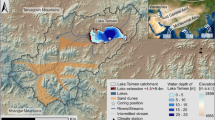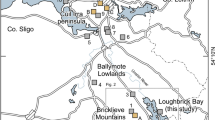Abstract
The limnological record of human impact on catchment land cover and on lake sedimentation during the historical period has been established for Pinto Lake in Central Coastal California. In addition, the sedimentary record of the ‘pre-impact’ condition preserves evidence of a climatic control on the nature of lake sedimentation. Chronological marker horizons have been determined using pollen data in combination with the documented land-use history and introductions of exotic species. Further chronological data have been determined using 14C and 137Cs. The impact of Mexican and Euro-American immigrants and their ‘imported’ land-use practices is clearly reflected in an order of magnitude increase in the rate of lake sedimentation to c. 9 kg m−2 year−1 (c. 2 cm year−1) between 1770 and 1850. Here, the occurrence of exotic plant species indicates disturbance as early as c. 1769–1797, whilst redwood deforestation between 1844 and 1860 represents the most significant human impact. Changes in the nature of sedimentation prior to this reveal a high degree of sensitivity to changes in precipitation where subtle decreases in lake level and the supply of runoff-derived mineral matter have resulted in two periods of organic lake sedimentation c. 650–900 and 1275–1750. Set against this background condition of high sensitivity, the dramatic impacts of Euro-American settlement are unsurprising.






Similar content being viewed by others
References
Allen RH (1935) The Spanish land grant system as an influence in the agricultural development of California. Agric Hist 9(3):126–142
Appleby PG, Nolan PJ, Gifford DW, Godfrey MJ, Oldfield F, Anderson NJ, Battarbee RW (1986) 210Pb dating by low background gamma counting. Hydrobiologia 141:21–27
Battarbee RW (2000) Palaeolimnological approaches to climate change, with special reference to the biological record. Quaternary Sci Rev 19:107–124
Brugam RB (1978) Pollen indicators of land-use change in southern Connecticut. Quaternary Res 9:349–362
Brush GS (1989) Rates and patterns of estuarine sediment accumulation. Limnol Oceanogr 34(7):1235–1246
Brush GS (1994) The Chesapeake Bay estuarine system. In: Roberts N (ed) The changing global environment. Blackwell, Oxford, pp 397–416
Brush GS, Martin EA, DeFries RS, Rice CA (1982) Comparisons of 210Pb and pollen methods of determining rates of estuarine sediment accumulation. Quaternary Res 18:196–217
Cayan DR, Redmond KT, Riddle LG (1999) ENSO and hydrologic extremes in the western United States. J Clim 12:2881–2893
Cole KL, Liu G-W (1994) Holocene paleoecology of an estuary on Santa Rosa Island, California. Quaternary Res 41:326–335
Cooke RU, Reeves RW (1976) Arroyos and environmental change in the American South-West. Clarendon Press, Oxford, p 213
Davis MB (1976) Erosion rates and land use history in southern Michigan. Environ Conserv 3(2):139–148
Davis OK (1992) Rapid climatic change in coastal southern California inferred from pollen analysis of San Joaquin Marsh. Quaternary Res 37:89–100
Davies SJ, Metcalfe SE, MacKenzie AB, Newton AJ, Endfield GH, Farmer JG (2004) Environmental changes in the Zirahuen Basin, Michoacan, Mexico, during the last 1000 years. J Palaeolimnol 31(1):77–98
Diaz HF, Markgraf V (eds) (1992) El Niño. Historical and Paleoclimatic aspects of the southern oscillation. Cambridge University Press, Cambridge
Dupre WC (1975) Quaternary history of the Watsonville lowlands, North Central Monterey Bay region, California. Unpublished PhD Thesis, Stanford University, p 145
Eittreim SL, Xu JP, Noble M, Edwards BD (2002) Towards a sediment budget for the Santa Cruz shelf. Mar Geol 181:235–248
Ely LL, Enzel Y, Baker VR, Cayan DR (1993) A 5000-year record of extreme floods and climate change in the southwestern United States. Science 262:410–412
Engstrom WN (1996) The California storm of January 1862. Quaternary Res 46:141–148
Frenkel RE (1970) Ruderal vegetation along some California roadsides. University of California Publications in Geography, 20, University of California Press, Berkeley, p 163
Fu C, Diaz HF, Fletcher JO (1986) Characteristics of the response of SST in the central Pacific associated with warm episodes of the southern oscillation. Mon Weather Rev 114:1716–1738
Gordon BL (1996) Monterey Bay area: natural history and cultural imprints. The Boxwood Press, California, p 375
Griffen K (1975) Vegetation studies and modern pollen spectra from the Red Lake peatland, Northern Minnesota. Ecology 56:531–546
Grunwald et al (1974) Environmental impact report. Pinto Lake regional park, Santa Cruz County, F868-S3G, 78
Jarrell R (1982) History. In: Warrick SF (eds) The natural history of the UC Santa Cruz Campus. Publication no.11, Environmental Field Program, University of California, Santa Cruz, pp 1–33
Johnson DL (1977) The origin of island mammoths and the quaternary land bridge history of the northern Channel Islands, California. Quaternary Res 10:204–225
Keeley JE (2002) Native American impacts on fire regimes of the California coast ranges. J Biogeogr 29:303–320
Kiladis GN, Diaz HF (1989) Global climatic anomalies associated with extremes in the Southern Oscillation. J Clim 2:965–976
Knox JC (2000) Sensitivity of modern and Holocene floods to climate change. Quaternary Sci Rev 19:439–457
Lantis DW (1970) California: land of contrast, 2nd edn. Wadsworth Publishing Company Inc, Belmont
Lewis B (1994) Watsonville remembered – a selection of KOMY-radio broadcasts. Santa Cruz County History Journal 1, Santa Cruz Historical Trust Inc
Lydon S (1994) Toward rediscovering the Monterey Bay region and its history. Santa Cruz County Hist J 1:4–8
Mannion AM (1995) Agriculture and environmental change: temporal and spatial dimensions. Wiley, Chichester
Martin PS (1963) The last 10,000 Years. A fossil pollen record of the American Southwest. University of Arizona Press, Tucson
Mayers C (2001) An environmental history of the recent human and climatic impacts on Central Coastal California: the Record from Pinto Lake, Santa Cruz County. Unpublished PhD Thesis, University of Liverpool, p 287
McCabe GJ, Dettinger MD (1999) Decadal variations in the strength of ENSO teleconnections with precipitation in the western United States. Int J Climatol 19:1399–1410
Mensing S, Byrne R (1998) Pre-mission invasion of Erodium cicutarium in California. J Biogeogr 25:757–762
Michaelson J, Haston L, Davis FW (1987) 400 years of central California precipitation variability reconstructed from tree-rings. Water Resour Bull 23(5):809–818
Mudie PJ, Byrne R (1980) Pollen evidence for historic sedimentation rates in California coastal marshes. Estuarine Coastal Mar Sci 10:305–316
Patch D, Jones T (1984) Paleoenvironmental change at Elkhorn Slough: implications for human adaptive strategies. J Calif Gt Basin Anthropol 6(1):19–43
Pennington W, Cambray RS, Fisher EM (1973) Observations on lake sediments using fallout 137Cs as a tracer. Nature 242:324–326
Redmond KT, Koch RW (1991) Surface climate and streamflow variability in the western United States and their relationship to large-scale circulation indices. Water Resour Res 27:2381–2399
Robbins JA, Edgington DN, Kemp ALW (1978) Comparative 210Pb, 137Cs, and pollen geochronologies of sediments from Lakes Ontario and Erie. Quaternary Res 10:256–278
Santos RL (1997) The Eucalyptus of California. Alley-Cass Publications, California
Schonher T, Nicholson SE (1989) The relationship between California rainfall and ENSO events. J Clim 2(11):1258–1269
Turner S (2000) High resolution palaeoenvironmental analyses of coastal wetland sediments from south east Sicily. Unpublished PhD Thesis, Brunel University
Watson S (1880) California Geological Survey: vol 1, Botany. Harvard University Press, Cambridge
Wolanski E, Boorman LA, Chicharo L, Langlois-Salou E, Lara R, Plater AJ, Uncles RJ, Zalewski M (2004) Ecohydrology as a new tool for sustainable management of estuaries and coastal waters. Wetland Ecol Manag 12:235–276
Zalewski M (2002) Ecohydrology—the use of ecological and hydrological processes for sustainable management of water resources. Hydrol Processes 47:823–832
Acknowledgements
The authors would like to thank Peter Appleby for undertaking the gamma-spectrometry in the Environmental Radioactivity Research Centre, University of Liverpool. Scott Anderson is thanked for his kind assistance with the identification of the pollen, and Gerry Weber for help with the fieldwork and providing essential equipment. Chris Spencer and Richard Mourne are acknowledged for their assistance with the collection of PL2001—which was made possible through financial assistance from the University of the West of England as well as the University of Liverpool. Thanks are also extended to Traci Roberts, Rob Ketley, Burton Gordon and Sandy Lydon for their assistance concerning the environmental history of Pinto Lake, and to the numerous field assistants including: Dave McKnight, Andy Morse, Katie Willis and Matt Wright. Sandra Mather is also acknowledged for the final production of the figures, and Hilda Hull, Irene Cooper and Bob Jude for their technical support. This research formed the basis of a PhD studentship completed by Claire Mayers, which was funded via the Department of Geography, University of Liverpool, Dumkow Scholarship.
Author information
Authors and Affiliations
Corresponding author
Additional information
An erratum to this article can be found at http://dx.doi.org/10.1007/s10113-006-0016-y
Rights and permissions
About this article
Cite this article
Plater, A.J., Boyle, J.F., Mayers, C. et al. Climate and human impact on lowland lake sedimentation in Central Coastal California: the record from c. 650 ad to the present. Reg Environ Change 6, 71–85 (2006). https://doi.org/10.1007/s10113-006-0013-1
Received:
Accepted:
Published:
Issue Date:
DOI: https://doi.org/10.1007/s10113-006-0013-1




